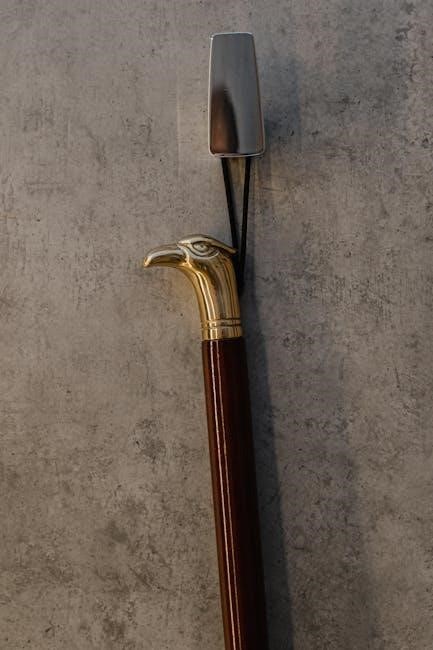Understanding t-shirt measurements is crucial for ensuring a perfect fit. Accurate sizing involves measuring key parameters like chest‚ sleeve length‚ and body length. Proper fit enhances comfort and style‚ making it essential to master these measurements for optimal wardrobe choices.
1.1 Importance of Accurate Fit
Accurate fit is essential for both style and comfort. Ill-fitting t-shirts can cause discomfort or an unflattering appearance. Proper measurements ensure the right size‚ crucial as brands vary in sizing. A well-fitting t-shirt enhances confidence and ensures optimal comfort throughout the day‚ making it a wardrobe staple. Using sizing guides and tools helps achieve the perfect fit tailored to your body.
1.2 Key Measurement Parameters
The key measurement parameters for t-shirts include chest width‚ sleeve length‚ and body length; These measurements ensure a proper fit and comfort. Chest width is measured across the fullest part‚ sleeve length from the shoulder to cuff‚ and body length from collar to hem. Accurate measurements of these parameters help in selecting the right size‚ ensuring both comfort and style are maintained.
How to Measure Your Body for a T-Shirt
Measuring your body involves taking chest circumference‚ sleeve length‚ and body length. These measurements help determine your ideal t-shirt size for a comfortable and flattering fit.
2.1 Chest Measurement
Measuring your chest is essential for determining the best t-shirt fit. Wrap a flexible tape measure around the fullest part of your chest‚ keeping it level and parallel to the floor. Position the tape just under your armpits and ensure it’s snug but not too tight. This measurement helps identify your ideal size for a comfortable and flattering fit.
2.2 Sleeve Length Measurement
To measure sleeve length‚ place the tape at the center back of your neck‚ extending it down over your shoulder and to your wrist. Keep your arm relaxed and the tape straight. This measurement ensures the sleeve fits neither too short nor too long‚ providing a balanced look and optimal comfort for everyday wear.
2.3 Body Length Measurement
Measure the body length by placing the tape at the highest point of your shoulder‚ extending it straight down to the desired hemline. This ensures the shirt is neither too short nor too long‚ providing a comfortable and stylish fit that aligns with your personal preference.

Measuring a T-Shirt
Measuring a t-shirt involves laying it flat and taking key measurements like chest width‚ sleeve length‚ and body length to ensure accuracy and proper fit.
3.1 Chest Width
Chest width is measured across the t-shirt from one armpit to the other‚ with the garment laid flat. This measurement ensures the perfect fit and comfort. Accurate chest width helps determine the ideal size‚ ensuring the t-shirt isn’t too tight or too loose. Compare this measurement to sizing charts for the best fit‚ as variations exist between brands and styles.
3.2 Sleeve Length
Sleeve length is measured from the center of the neckline to the sleeve’s end while the t-shirt is laid flat. This measurement ensures sleeves fit comfortably without being too short or too long. Accurate sleeve length is vital for both style and comfort‚ as it impacts the overall appearance and usability of the t-shirt. Compare this to sizing charts for consistency across brands and styles.
3.3 Body Length
Body length is measured from the top of the neckline to the bottom of the hem while the t-shirt is laid flat. This measurement ensures the shirt fits neither too short nor too long‚ providing optimal coverage and comfort. Accurate body length is essential for maintaining the intended style and fit‚ making it a critical factor in t-shirt sizing and comfort.
Understanding T-Shirt Sizing Charts
T-shirt sizing charts provide standardized measurements for chest‚ length‚ and sleeve length. They help determine the best fit based on body measurements‚ ensuring comfort and style. Comparing measurements to these charts is essential for selecting the right size‚ especially across different brands with varying sizing standards.
4.1 Standard Sizing Charts
Standard sizing charts provide a universal guide for t-shirt measurements‚ typically including chest‚ body length‚ and sleeve length. They categorize sizes from Small to Extra-Large‚ offering a baseline for fit. These charts help consumers choose the right size based on body measurements‚ ensuring a consistent fit across different brands. They often include measurements in both inches and centimeters for global applicability.
4.2 Differences Between Brands
While standard sizing charts offer a baseline‚ brands often have unique interpretations‚ leading to variations in fit. For example‚ Gildan and Bella Canvas may differ in chest width or sleeve length for the same size. Some brands cater to specific fits like slim‚ regular‚ or relaxed‚ while others may adjust sizing based on regional preferences or fabric types‚ making direct comparisons challenging.
Using a T-Shirt Size Calculator
A t-shirt size calculator simplifies finding your perfect fit by converting body measurements into corresponding sizes. It saves time and reduces guesswork‚ ensuring accuracy and convenience across brands.
5.1 Benefits of a Size Calculator
A t-shirt size calculator offers numerous benefits‚ including time-saving and improved accuracy. It eliminates the hassle of trial and error by providing precise size recommendations based on your measurements‚ ensuring a perfect fit every time. Additionally‚ it accommodates variations between brands‚ making it a reliable tool for confident shopping across different labels and styles.
5.2 How to Use One Effectively
To use a t-shirt size calculator effectively‚ start by inputting your precise body measurements‚ such as chest circumference and height. Select your preferred fit style‚ whether slim‚ regular‚ or relaxed. The calculator will then match your dimensions to the closest size. This method ensures accuracy and saves time‚ especially when ordering custom designs or comparing sizes across different brands.
Factors Influencing Fit
Fabric type‚ fit styles‚ and shrinkage significantly impact t-shirt fit. Fabric stretch‚ thickness‚ and weave affect comfort and shape. Slim‚ regular‚ or relaxed fits cater to different body types‚ while shrinkage alters post-wash sizing.
6.1 Fabric Type
Fabric type plays a crucial role in determining t-shirt fit and comfort. Cotton‚ polyester‚ and blends vary in stretch‚ breathability‚ and softness. Thicker fabrics like heavyweight cotton provide structure‚ while lightweight blends offer a snug feel. The fabric’s weave and texture also influence how it drapes and conforms to the body‚ impacting the overall fit. Choose fabrics that suit your lifestyle and preference for optimal comfort.
6.2 Fit Styles (Slim‚ Regular‚ Relaxed)
T-shirt fit styles vary to cater to different preferences. Slim fit offers a tailored look‚ hugging the body closely. Regular fit provides a classic‚ comfortable silhouette with moderate looseness. Relaxed fit is loose and casual‚ ideal for a laid-back style. Each style serves different body types and personal tastes‚ ensuring a flattering and comfortable wear experience.
6.3 Shrinkage After Washing
Fabric shrinkage after washing can alter a t-shirt’s fit. Natural fibers like cotton often shrink more than blends. To minimize this‚ wash in cold water and avoid heat drying. Checking care labels and pre-shrinking fabrics before purchase helps maintain the desired fit. Understanding shrinkage ensures your t-shirt remains comfortable and well-fitting over time.
How to Choose the Right Size
Choosing the right t-shirt size involves comparing your measurements to sizing charts and considering personal fit preferences. Accurate measurements ensure comfort and style‚ making it essential to select sizes that align with your body dimensions for the best fit.
7.1 Comparing Measurements to Sizing Charts
Comparing your body measurements to a sizing chart ensures the best fit. Measure your chest‚ sleeve length‚ and body length‚ then match these to the chart. Consider key parameters like chest width‚ sleeve length‚ and body length. Use a flexible tape measure for accuracy. This step helps you identify the size that aligns with your body dimensions‚ ensuring comfort and style.
7.2 Considering Personal Fit Preferences
Personal fit preferences play a significant role in choosing the right t-shirt size. Some prefer a slim fit for a modern look‚ while others opt for a relaxed fit for comfort. Consider your lifestyle‚ activity level‚ and style goals. Ensure the fit aligns with your body type and personal comfort‚ balancing aesthetics with practicality for the perfect choice.
Tips for Taking Accurate Measurements
Ensure smooth fabric and proper alignment when measuring. Use a flexible tape measure for accuracy‚ and take measurements while the garment is laid flat.
8.1 Measuring Flat vs. On the Body
Measuring a T-shirt flat ensures accuracy and consistency‚ especially for comparing sizes across brands. Measuring on the body provides a personal fit but may vary due to fabric drape. For precise results‚ lay the garment flat and use a flexible tape measure‚ ensuring smooth fabric and proper alignment. Double-check measurements for consistency and reliability.
8.2 Using a Flexible Tape Measure
A flexible tape measure is essential for accurate T-shirt measurements. It conforms to body curves‚ ensuring precise results. When measuring‚ lay the garment flat and smooth out wrinkles. Use the tape measure to record chest width‚ sleeve length‚ and body length. This tool minimizes errors and provides consistent measurements for the perfect fit.

Common Mistakes to Avoid
Common mistakes include incorrect measuring techniques and not considering fabric shrinkage‚ which can lead to poor fit. Avoid these errors for accurate T-shirt sizing.
9.1 Incorrect Measuring Techniques
Common mistakes include not using a flexible tape measure‚ measuring while garments are on the body‚ and not aligning the tape correctly. Measuring flat is essential for accuracy. Incorrect techniques often result in ill-fitting shirts‚ emphasizing the importance of precise measurements for the best fit.
9.2 Not Considering Fabric Shrinkage
Neglecting fabric shrinkage can lead to t-shirts that fit poorly after washing. Natural fibers like cotton often shrink‚ altering measurements and causing discomfort. To avoid this‚ opt for pre-shrunk fabrics or consider slightly larger sizes. Always check care labels and follow washing instructions carefully to maintain the fit and longevity of your t-shirts effectively‚ ensuring optimal comfort and appearance.
Different Fits
T-shirts come in various fits‚ including slim‚ regular‚ and relaxed. These fits offer a range of styles‚ from tight to loose‚ allowing individuals to choose what suits their body type and personal style best.
10.1 Slim Fit
A slim fit t-shirt is designed to fit closely to the body‚ offering a modern‚ tailored look. It is ideal for those with a lean or athletic build‚ as it accentuates the body’s natural shape. The measurements for a slim fit are slightly narrower in the chest‚ shoulders‚ and body length compared to regular or relaxed fits‚ providing a contemporary aesthetic while maintaining comfort. Accurate measurements are essential for the right fit.
10.2 Regular Fit
A regular fit t-shirt offers a balanced‚ classic silhouette that is neither too tight nor too loose. It is designed for everyday wear‚ providing comfort and ease of movement. The measurements for a regular fit are slightly roomier than slim fit but not as generous as relaxed fit‚ making it suitable for a wide range of body types and personal style preferences.
10.3 Relaxed Fit
A relaxed fit t-shirt offers a loose‚ comfortable design with ample room for movement. It features a roomier chest‚ longer sleeves‚ and a fuller body length compared to slim or regular fits. This style is ideal for casual wear‚ providing a laid-back look while maintaining comfort. The relaxed fit is perfect for those who prefer a more generous‚ oversized silhouette without feeling restrictive.

Measuring for Custom T-Shirts
Measuring for custom t-shirts requires precision to ensure a tailored fit. Use a flexible tape measure to accurately capture chest‚ sleeve‚ and body length‚ then compare to a sizing chart for the best results.
11.1 Steps for Custom Measurements
To measure for custom t-shirts‚ start by gathering a flexible tape measure and laying the garment flat. Measure the chest width across the fullest part‚ sleeve length from the shoulder seam to cuff‚ and body length from neckline to hem. Record each measurement accurately and compare it to a sizing chart to ensure the best fit for your custom design.
11.2 Tools Needed
To accurately measure for custom t-shirts‚ you’ll need a few essential tools. A flexible tape measure (at least 36 inches long) is crucial for taking precise body and garment measurements. A flat surface to lay the t-shirt on‚ a pen‚ and paper or a digital tool for recording measurements are also necessary. These tools ensure accuracy and help create a tailored fit for your custom design.

International Size Differences
T-shirt sizes vary globally‚ with different standards in the US‚ EU‚ and UK. Understanding regional sizing differences is key to avoiding mismatches when shopping internationally.
12.1 Regional Variations
Regional variations in t-shirt sizing are significant. In the US‚ sizes are based on chest measurements‚ while EU sizes often use body measurements. Asian countries may have smaller cuts. These differences can lead to discrepancies‚ making it essential to refer to specific regional sizing charts for accurate fits when shopping across borders.
12.2 Size Conversions
Converting t-shirt sizes between regions requires careful comparison of sizing charts. For example‚ a US Medium often aligns with an EU Large. Use size conversion tools or charts to match measurements accurately. Understanding these differences ensures the right fit when shopping internationally or across brands with varying regional sizing standards.
Care Tips for T-Shirts
Wash t-shirts in cold water to prevent shrinkage and fading. Avoid using bleach or harsh detergents. Air-dry or tumble dry on low heat to maintain fabric quality and fit.
13.1 Washing Instructions
For optimal care‚ wash t-shirts in cold water to prevent shrinkage and fading. Use a gentle detergent and avoid bleach or harsh chemicals. Turn shirts inside out before washing to protect designs. Opt for a gentle cycle or hand wash for delicate fabrics. Air-drying is recommended‚ but if using a dryer‚ select a low-heat setting to maintain fabric quality and fit.
13.2 Drying Methods
Air-drying is the best method to preserve t-shirt quality. Lay shirts flat or hang them to prevent stretching. Avoid direct sunlight to minimize fading. Reshape the garment while damp to maintain its original dimensions. If using a dryer‚ select a low-heat setting to avoid shrinkage. Proper drying ensures longevity and maintains the fit and appearance of your t-shirts.
